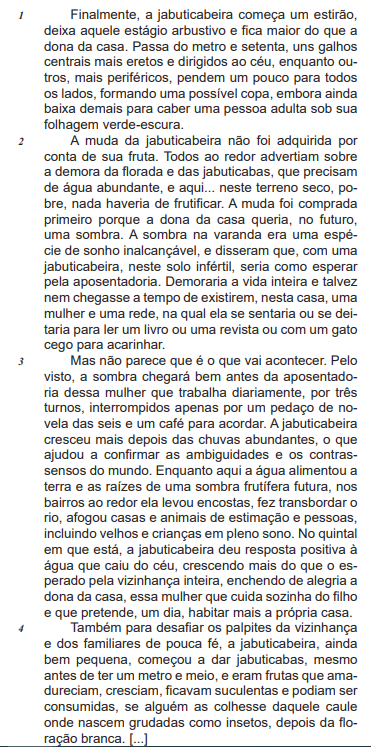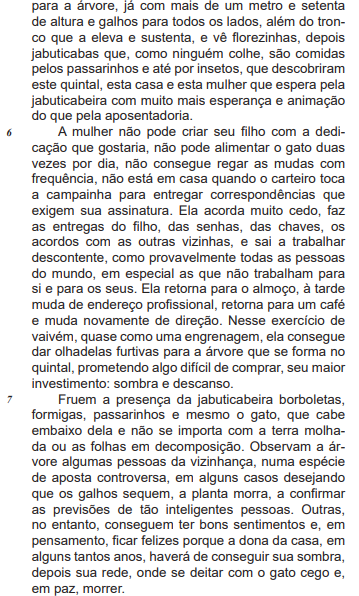Questões de Concurso
Para publicitário
Foram encontradas 1.058 questões
Resolva questões gratuitamente!
Junte-se a mais de 4 milhões de concurseiros!
Sombra e água



RIBEIRO, A. E. Sombra e água. Estado de Minas. Belo
Horizonte. Disponível em: https://www.em.com.br/cultura/.
Acesso em: 6 nov. 2023. Adaptado.
A frase que suscita duas leituras possíveis é:
Sombra e água



RIBEIRO, A. E. Sombra e água. Estado de Minas. Belo
Horizonte. Disponível em: https://www.em.com.br/cultura/.
Acesso em: 6 nov. 2023. Adaptado.
Como ninguém colhe as jabuticabas, elas são comidas pelos passarinhos e até por insetos.
Nesse período, a palavra destacada constrói, entre as duas orações, uma relação semântica de
Sombra e água



RIBEIRO, A. E. Sombra e água. Estado de Minas. Belo
Horizonte. Disponível em: https://www.em.com.br/cultura/.
Acesso em: 6 nov. 2023. Adaptado.
Sombra e água



RIBEIRO, A. E. Sombra e água. Estado de Minas. Belo
Horizonte. Disponível em: https://www.em.com.br/cultura/.
Acesso em: 6 nov. 2023. Adaptado.
Sombra e água



RIBEIRO, A. E. Sombra e água. Estado de Minas. Belo
Horizonte. Disponível em: https://www.em.com.br/cultura/.
Acesso em: 6 nov. 2023. Adaptado.
Sombra e água



RIBEIRO, A. E. Sombra e água. Estado de Minas. Belo
Horizonte. Disponível em: https://www.em.com.br/cultura/.
Acesso em: 6 nov. 2023. Adaptado.
Sombra e água



RIBEIRO, A. E. Sombra e água. Estado de Minas. Belo
Horizonte. Disponível em: https://www.em.com.br/cultura/.
Acesso em: 6 nov. 2023. Adaptado.
Internet: <fastercapital.com> (con adaptaciones).
Según el texto anterior, los anuncios intersticiales
Internet: <adevinta.es> (con adaptaciones).
De acuerdo con el texto anterior, juzgue los siguientes ítems.
I La palabra “Sus” en “Sus mensajes” corresponde a una forma masculina del pronombre posesivo.
II La frase “pueden impulsar” tiene como sujeto a “la mano”.
III La palabra “sino” une dos ideas que se contraponen.
IV En la frase “del presente y del futuro de la industria de la publicidad” se usa cuatro veces la preposición de.
Seleccione la opción correcta.
Internet: <geformas.com.mx> (con adaptaciones).
De acuerdo con el texto anterior, juzgue los siguientes ítems.
I Activistas y profesionales del arte gráfico tienen la meta de un diseño sostenible.
II El uso de diferentes materiales permitirá en el futuro mejorar el compromiso de la industria gráfica con el medio ambiente.
III Varios tipos de arte, además del gráfico, utilizan la impresión en diferentes materiales.
IV Todavía se siguen usando formatos gráficos tradicionales pero el efecto negativo sobre el medio ambiente ha disminuido.
Seleccione la opción correcta.

Internet: <ande.gov.py> (con adaptaciones).
De acuerdo con el texto anterior, juzgue los siguientes ítems.
I La palabra “heladera” se refiere al clima y los cuidados con los alimentos.
II Las formas verbales “abrí” y “Tenes” corresponden a la segunda persona del singular.
III El término “cuando sea necesario” es un complemento que indica tempo.
IV La frase “para ahorrar más” es un complemento que indica cantidad.
Seleccione la opción correcta.
Internet: <dialnet.unirioja.es> (con adaptaciones).
De acuerdo con el texto anterior, juzgue los siguientes ítems.
I El rol de la publicidad del Estado español luego de la dictadura fue destacado.
II Las antiguas formas de divulgación se volvieron y habían causado un gran cansancio.
III La emergencia de la publicidad institucional es un indicador del fortalecimiento de la ciudadanía.
IV La victoria socialista fue posterior al fin de la dictadura.
Seleccione la opción correcta.
Text 19A4-II
Photo exhibitions are great opportunities for excited and ambitious photographers to showcase their work beyond just the safety of their friends and family. They’re also a stellar opportunity to develop a thicker skin, as your work will be subject to critique, but that’s all part of the territory that comes with getting more exposure as a photographer, which is what all artists should strive for. Beyond that, they’re a great way to advertise yourself as a photographer, both your talents and your availability. Think of it almost as the artist’s equivalent to having a booth at a trade show when you’re selling a product.
First-timers to an exhibition will likely find themselves a bit unsure of what to do and somewhat nervous. Here’s a series of surefire tips to make any exhibition a success. Before you do anything else, it’s imperative that you make up your mind about what you’ll be showcasing at your exhibition. You only have two choices, when you think about it: brand-new work that you’ll shoot especially for the exhibition or archival stuff that you’ll just pull out for the exhibition. Also, being creative when finding the exhibition location is as important as the showcase itself.
Internet: <https://contrastly.com> (adapted).
Text 19A4-II
Photo exhibitions are great opportunities for excited and ambitious photographers to showcase their work beyond just the safety of their friends and family. They’re also a stellar opportunity to develop a thicker skin, as your work will be subject to critique, but that’s all part of the territory that comes with getting more exposure as a photographer, which is what all artists should strive for. Beyond that, they’re a great way to advertise yourself as a photographer, both your talents and your availability. Think of it almost as the artist’s equivalent to having a booth at a trade show when you’re selling a product.
First-timers to an exhibition will likely find themselves a bit unsure of what to do and somewhat nervous. Here’s a series of surefire tips to make any exhibition a success. Before you do anything else, it’s imperative that you make up your mind about what you’ll be showcasing at your exhibition. You only have two choices, when you think about it: brand-new work that you’ll shoot especially for the exhibition or archival stuff that you’ll just pull out for the exhibition. Also, being creative when finding the exhibition location is as important as the showcase itself.
Internet: <https://contrastly.com> (adapted).
Text 19A4-I
It is a universal fact that cinema is a visual medium. Films have the power to overwhelm our senses as well as our minds, subjecting us to a variety of experiences that can range from the sublime to the devastating. Colours play a crucial role in this interesting phenomenon, forming an integral part of the composition of each frame and dictating how the viewer perceives the spectacle on the screen. Apart from the cinematic medium, colours have always been a part of our experience and how we make sense of the vastly nuanced world around us. Although science has definitively explained what colours are in terms of light, they have always mystified artists and philosophers like Arthur Schopenhauer and Ludwig Wittgenstein, who tried to understand their importance in anthropological frameworks.
More notably, the famous German poet and artist Johann Wolfgang von Goethe published a seminal exploration of colours in his 1810 work Theory of Colours. In it, he examined how each colour corresponds to various psychological states in the minds of human beings. He wrote, “Light and darkness, brightness and obscurity, or if a more general expression is preferred, light and its absence, are necessary to the production of colour… Colour itself is a degree of darkness.” Goethe’s theories might seem baselessly romantic in the 21st century but the underlying ideas have been implemented by filmmakers and cinematographers to curate the voyeuristic experiences of their audiences. Famed cinematographer Vittorio Storaro has based his artistic vision on Goethe’s work, insisting that colours do have a direct connection to the mind of the viewer.
Internet: <https://faroutmagazine.co.uk> (adapted).
Text 19A4-I
It is a universal fact that cinema is a visual medium. Films have the power to overwhelm our senses as well as our minds, subjecting us to a variety of experiences that can range from the sublime to the devastating. Colours play a crucial role in this interesting phenomenon, forming an integral part of the composition of each frame and dictating how the viewer perceives the spectacle on the screen. Apart from the cinematic medium, colours have always been a part of our experience and how we make sense of the vastly nuanced world around us. Although science has definitively explained what colours are in terms of light, they have always mystified artists and philosophers like Arthur Schopenhauer and Ludwig Wittgenstein, who tried to understand their importance in anthropological frameworks.
More notably, the famous German poet and artist Johann Wolfgang von Goethe published a seminal exploration of colours in his 1810 work Theory of Colours. In it, he examined how each colour corresponds to various psychological states in the minds of human beings. He wrote, “Light and darkness, brightness and obscurity, or if a more general expression is preferred, light and its absence, are necessary to the production of colour… Colour itself is a degree of darkness.” Goethe’s theories might seem baselessly romantic in the 21st century but the underlying ideas have been implemented by filmmakers and cinematographers to curate the voyeuristic experiences of their audiences. Famed cinematographer Vittorio Storaro has based his artistic vision on Goethe’s work, insisting that colours do have a direct connection to the mind of the viewer.
Internet: <https://faroutmagazine.co.uk> (adapted).
Text 19A4-I
It is a universal fact that cinema is a visual medium. Films have the power to overwhelm our senses as well as our minds, subjecting us to a variety of experiences that can range from the sublime to the devastating. Colours play a crucial role in this interesting phenomenon, forming an integral part of the composition of each frame and dictating how the viewer perceives the spectacle on the screen. Apart from the cinematic medium, colours have always been a part of our experience and how we make sense of the vastly nuanced world around us. Although science has definitively explained what colours are in terms of light, they have always mystified artists and philosophers like Arthur Schopenhauer and Ludwig Wittgenstein, who tried to understand their importance in anthropological frameworks.
More notably, the famous German poet and artist Johann Wolfgang von Goethe published a seminal exploration of colours in his 1810 work Theory of Colours. In it, he examined how each colour corresponds to various psychological states in the minds of human beings. He wrote, “Light and darkness, brightness and obscurity, or if a more general expression is preferred, light and its absence, are necessary to the production of colour… Colour itself is a degree of darkness.” Goethe’s theories might seem baselessly romantic in the 21st century but the underlying ideas have been implemented by filmmakers and cinematographers to curate the voyeuristic experiences of their audiences. Famed cinematographer Vittorio Storaro has based his artistic vision on Goethe’s work, insisting that colours do have a direct connection to the mind of the viewer.
Internet: <https://faroutmagazine.co.uk> (adapted).
Joaquim da Fonseca. Tipografia e design gráfico. São Paulo: Grupo A, 2011 (com adaptações).
Considerando a descrição apresentada no texto anterior, assinale a opção correta, acerca do processo de impressão offset.